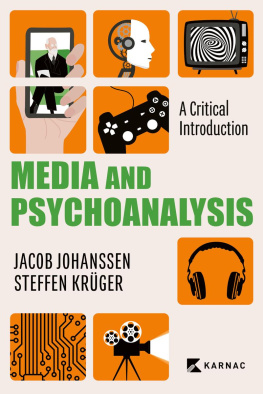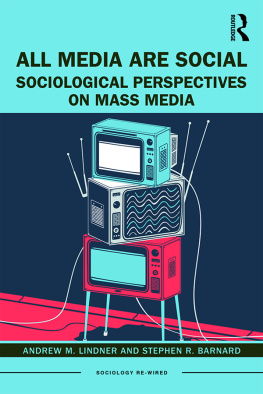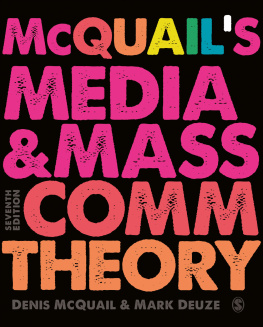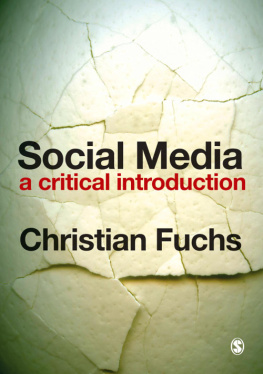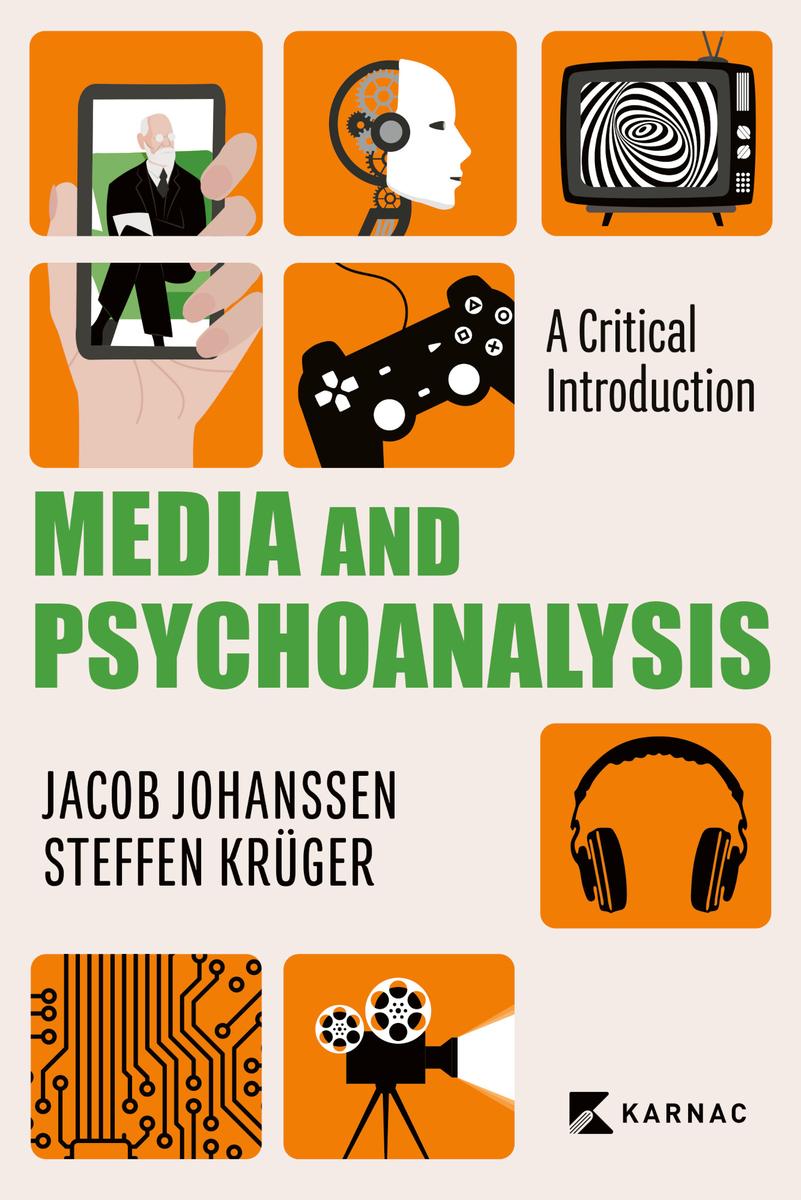This book is the result of an intense work process and countless dialogues and discussions we had on, with, in and via digital media. We are glad its done, but we are still glad weve done it.
Thank you, Jacob. Thank you, Steffen. The authors.
I n 1907, Sigmund Freud wrote to his family while he was on holiday in Italy. On the Piazza Colonna in Rome, a screen had been installed on the roof of one of the buildings onto which magic lantern slides and moving images were projected:
They [the magic lantern slides] are actually advertisements, but to beguile the public these are interspersed with pictures of landscapes, Negroes [sic] of the Congo, glacier ascents, and so on. But since these wouldnt be enough, the boredom is interrupted by short cinematographic performances for the sake of which the old children (your father included) suffer quietly the advertisements and monotonous photographs. They are stingy with these tidbits, however, so I have had to look at the same thing over and over again. When I turn to go I detect a certain tension in the crowd, which makes me look again, and sure enough a new performance has begun, and so I stay on. Until 9 p.m. I usually remain spellbound; then I begin to feel too lonely in the crowd. (Freud, 1992, pp. 2612)
Written well over a hundred years ago, the scene that Freud describes here may nevertheless sound familiar to us. Big screens in public places on mild summer nights have long since become a cultural mainstay and frequently attract hundreds, even thousands, of people to experience, say, a sporting event together.
As art and media historian Pasi Vliaho (2013) observes of Freuds report, under the pull of the technological spectacle, the external environment of the Piazza becomes secondary (2013, p. 169). His eyes glued to the screen, Freud finds himself suffering through the advertisements, as so many television viewers in the decades that would follow, but he admits to being spellbound by the moving images offered in between the ads and the slideshows. Indeed, the spectacle of movement on the screen fascinates him so much as to render him immobile, if only for a short moment. More than that, each time he attempts to turn his back on the screen and leave, he can sense in the physical responses of other spectators that something new is catching their attention, which makes him turn around again only to become spellbound once more.
Although the magic lantern was one of the key inventions predating and anticipating cinema with the first properly moving images having been made and shown by Louis Le Prince in 1888 we can link the repetitive, tidbit nature of the screening at the Piazza Colonna to contemporary media technology. Indeed, the historical scene is reminiscent of the photo- and video-sharing app Snapchat, for example, where users can share up to 60-second-long videos with friends. Furthermore, the magic lantern slides can also be seen as early instances of animated gif images that have become commonplace on social media: punchily short film sequences that are a few seconds long and repeat endlessly. The silent films and slideshows of Freuds era were often accompanied by live music to add an additional stimulus. This comes remarkably close to another current social media platform, TikTok, which draws its highly affective strength from the often funny and joyful visual illustrations of short samples of well-known pop music songs.
Turning to more traditional media, Rome, the eternal city, has been featured in countless Hollywood films, from La Dolce Vita (Fellini, 1960) and The Talented Mr. Ripley (Minghella, 1999), to Zoolander 2 (Stiller, 2016) and many others. It is also possible today to learn about Rome by watching videos of virtual walks on YouTube or to visit the city through a virtual-reality headset like Oculus Rift where users can interact with a virtual artificial intelligence (AI) tour guide. Videogames from Street Fighter Alpha (1995) and the Assassins Creed series (200716), to Gran Turismo 6 (2013) have all featured levels set in the Italian capital. Hence, although technology and media change rapidly, we can always find traces of the old in the new. As we shall see in the coming chapters, the spatio-temporal dynamics of repetition and in/visibility that we have evoked in the above passages are characteristic of both media and psychoanalysis. In this Introduction, we outline basic ideas of psychoanalysis and define key technological terms such as media. Lastly, we provide a summary of the books main arguments.
What is psychoanalysis?
This book is a critical introduction to media and psychoanalysis or, more precisely, the study of diverse media through a psychoanalytic lens. The coming chapters feature the technologies, practices, uses and genres already broached above: film and television, the internet and social media, videogames and AI. We present and develop the field of psychoanalytic media studies and show how scholars have drawn on psychoanalysis in their thinking about them.
But, first of all, what is psychoanalysis anyway? Founded by the Austrian neurologist Sigmund Freud (18561939), psychoanalysis is, first and foremost, a theory of the human mind, or the human being in general (the subject, a term many psychoanalysts prefer) and its peculiar ways of functioning. Taking its cues not from the well-functioning and healthy, but from the ailing mind, it consists of a clinical practice of caring for what today is referred to as mental health issues: for example, an inexplicable and overwhelming sadness (called depression), states of extreme, mysterious fearfulness (anxiety), obsessivecompulsive behaviours such as hoarding, and radical mood swings and emotional instabilities (classified today as bipolar or borderline, depending on the strength and character of the phenomena), as well as many others.
We can say that, together with his mostly female patients or analysands, as one calls them nowadays, so as to denote a more equal relationship in which both analyst and patient/analysand engage in mental work Freud discovered that people suffering from psychological turbulences could be significantly helped by talking about themselves and what is difficult in their lives during daily sessions. Although much has changed since then, the basic principles have remained the same. The analysand lies down on a couch and freely associates that is, talks about everything and anything that comes to their mind while the analyst sits at an angle behind them, taking in the analysands stream of (un)-consciousness with evenly hovering attention, trying not to focus their attention on any specific aspects of the analysands discourse, but bringing out the import of the overall scene thus created.
Psychoanalysts (or psychoanalytic therapists, psychodynamic therapists or depth psychologists, as they are often called) are trained in psychoanalytic institutes, not merely learning key psychoanalytic ideas, but experiencing them by submitting to psychoanalytic treatment themselves, long before they start seeing their own patients/analysands. Once accredited, they can set up their own practice.
Depending on where one lives in the world, the availability and affordability of psychoanalytic treatment vary greatly. For instance, psychoanalysis does not have a large presence in the Arab region, whereas the Argentinian city of Buenos Aires is said to have the most psychoanalysts per square mile. This might have to do with the practice being rooted in a western culture that puts emphasis on individuality the idea that each of us is their own, separate being, living their distinct lives. Paradoxically, clinical psychoanalysis affirms this idea each time an individual lies down on an analysts couch; at the same time, however, the aim of the treatment can be described as making individuals aware of their fundamental state of

